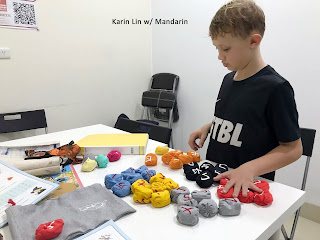[華語 Mandarin] 教材 | 依學生的需求量身訂做 Customised learning materials
一對一家教的挑戰,就是依學生的需求,量身訂做適合的教材。
由於"客戶"只有一位,在有限時間內提供他所需要的,就是老師最大的任務。
(English version is attached in the end)
學生是一位在美國科技公司工作的日本工程師
約有兩個月的時間來台灣出差,想學些中文
一週兩小時,因為時間很短,且要馬上開始上課
補習班已準備了初級的中文講義,確認學生需求:學會生活基本對話,
立刻回家備課,加強講義的內容。
我跟著講義主題 (例如:招呼語,時間,飲食等),大方向地去準備單字,
沒有花俏的字卡,我選擇加上補充用法,自製生活對話成投影片當教材。
對於學生來說,下課後能夠馬上用到說到的,就是實用會話。
由於是成人,我直接帶入句子,通過句子學單字。
對於初學者,一開始學怎麼回答通常比問問題簡單。
因為大部分的時間他們都是被問的,例如自我介紹時:
- 我叫_____
- 我是台灣人
- 我住在新竹
- 我會說中文和英文
但事實是,在台灣,他們更多的時候是要問問題和尋求協助。
當教到數字,時間或日期,我讓學生開始練習"問問題",例如:
- 請問現在幾點?
- 請問這個多少錢?
- 下次的會議是幾月幾號?
另外準備幾個好用句型,例如:(我)可以.....嗎?/ 可以(幫我)....嗎?
學生可抽換單字,向別人提出請求,因大部分的時候他們要尋求幫助
如此一來可應付生活中好幾種情況。
- 我可以看一下(這個)嗎?
- 可以幫我拿一下嗎?
- 可以幫我叫計程車嗎?(這句他每天要說)
- 我要去高鐵站,謝謝。
- 我要買客運票,謝謝。
- 我要一杯拿鐵,謝謝。
用學生生活常見的單字,反覆做一問一答的對話練習
當學生出了教室,可以馬上運用所學 - "現學現賣"
成功用中文請別人幫他叫車,路上還可以跟計程車司機閒聊幾句
他已對學中文充滿興趣和信心 - 這是學生親口和我說的。
*下次來分享:融合單字,如何設計對話內容。
---
The challenge for the teachers with one-to-one classes, is to prepare customised and suitable learning materials for your student.
Since you only have "one" client, the toughest task is to offer what the student need/require in such a short period of time.
My student is a Japanese engineer who's working in a high-tech company in the states. He has two months in Taiwan on a business trip and would like to learn some Mandarin.
Two-hour class per week - The language school prepared a book of handouts for beginners. Apart from the topics in the book, I'd like to add more sentences that the student may use in his daily life. No colourful flashcards, I created the slides with practical conversations as my substitute teaching materials.
Practical? If the students can use these sentences/conversations to communicate right after the class, then we call it practical.
My student is an adult - I lead to learn the sentences first, and highlight new words while learning the sentences.
For debutants, it's easier "to answer" than "to ask" in the beginning (since most time they're asked lots of questions by the locals). For example, doing self-introduction:
- I am (my name is) OOO
- I am Taiwanese
- I live in Hsinchu
- I can speak Mandarin and English
However, the students have to "ask" questions or for help most of the time.
When we teach numbers, dates and time, I let the students practice asking questions:
- What time is it?
- How much is it?
- When is the next meeting/conference?
I also prepare some useful sentences, including "May I please...? / Would you please..?" The students can just change words in the sentence to deal with various situations, for example:
- May I have a look (at this)?
- Could you hold this for me?
- Could you call a taxi for me? (My student needs to say this every day)
With useful responding sentences: I'd like to..., thank you.
- I'd like to go to the high speed rail station.
- I'd to buy coach ticket.
- I'd like to have one latte.
Practicing and repeating the conversations with different useful words, the students would be able to use the sentences outside the classroom - immediately.
When the student succeeded to ask someone to call a taxi for him, and he can talk to the taxi driver with the sentences he learned - He's definitely interested in learning Mandarin in full confidence - said my student in person.
*Next article: How to design the conversations with words combinations.
由於"客戶"只有一位,在有限時間內提供他所需要的,就是老師最大的任務。
(English version is attached in the end)
學生是一位在美國科技公司工作的日本工程師
約有兩個月的時間來台灣出差,想學些中文
一週兩小時,因為時間很短,且要馬上開始上課
補習班已準備了初級的中文講義,確認學生需求:學會生活基本對話,
立刻回家備課,加強講義的內容。
我跟著講義主題 (例如:招呼語,時間,飲食等),大方向地去準備單字,
沒有花俏的字卡,我選擇加上補充用法,自製生活對話成投影片當教材。
對於學生來說,下課後能夠馬上用到說到的,就是實用會話。
由於是成人,我直接帶入句子,通過句子學單字。
對於初學者,一開始學怎麼回答通常比問問題簡單。
因為大部分的時間他們都是被問的,例如自我介紹時:
- 我叫_____
- 我是台灣人
- 我住在新竹
- 我會說中文和英文
當教到數字,時間或日期,我讓學生開始練習"問問題",例如:
- 請問現在幾點?
- 請問這個多少錢?
- 下次的會議是幾月幾號?
另外準備幾個好用句型,例如:(我)可以.....嗎?/ 可以(幫我)....嗎?
學生可抽換單字,向別人提出請求,因大部分的時候他們要尋求幫助
如此一來可應付生活中好幾種情況。
- 我可以看一下(這個)嗎?
- 可以幫我拿一下嗎?
- 可以幫我叫計程車嗎?(這句他每天要說)
再搭配常用的回答句:我要....,謝謝。
- 我要去高鐵站,謝謝。
- 我要買客運票,謝謝。
- 我要一杯拿鐵,謝謝。
用學生生活常見的單字,反覆做一問一答的對話練習
當學生出了教室,可以馬上運用所學 - "現學現賣"
成功用中文請別人幫他叫車,路上還可以跟計程車司機閒聊幾句
他已對學中文充滿興趣和信心 - 這是學生親口和我說的。
*下次來分享:融合單字,如何設計對話內容。
---
The challenge for the teachers with one-to-one classes, is to prepare customised and suitable learning materials for your student.
Since you only have "one" client, the toughest task is to offer what the student need/require in such a short period of time.
My student is a Japanese engineer who's working in a high-tech company in the states. He has two months in Taiwan on a business trip and would like to learn some Mandarin.
Two-hour class per week - The language school prepared a book of handouts for beginners. Apart from the topics in the book, I'd like to add more sentences that the student may use in his daily life. No colourful flashcards, I created the slides with practical conversations as my substitute teaching materials.
Practical? If the students can use these sentences/conversations to communicate right after the class, then we call it practical.
My student is an adult - I lead to learn the sentences first, and highlight new words while learning the sentences.
For debutants, it's easier "to answer" than "to ask" in the beginning (since most time they're asked lots of questions by the locals). For example, doing self-introduction:
- I am (my name is) OOO
- I am Taiwanese
- I live in Hsinchu
- I can speak Mandarin and English
However, the students have to "ask" questions or for help most of the time.
When we teach numbers, dates and time, I let the students practice asking questions:
- What time is it?
- How much is it?
- When is the next meeting/conference?
I also prepare some useful sentences, including "May I please...? / Would you please..?" The students can just change words in the sentence to deal with various situations, for example:
- May I have a look (at this)?
- Could you hold this for me?
- Could you call a taxi for me? (My student needs to say this every day)
With useful responding sentences: I'd like to..., thank you.
- I'd like to go to the high speed rail station.
- I'd to buy coach ticket.
- I'd like to have one latte.
Practicing and repeating the conversations with different useful words, the students would be able to use the sentences outside the classroom - immediately.
When the student succeeded to ask someone to call a taxi for him, and he can talk to the taxi driver with the sentences he learned - He's definitely interested in learning Mandarin in full confidence - said my student in person.
*Next article: How to design the conversations with words combinations.


Comments
Post a Comment